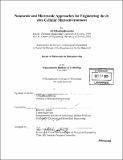Nanoscale and microscale approaches for engineering the in vitro cellular microenvironment
Author(s)
Khademhosseini, Ali
DownloadFull printable version (12.38Mb)
Other Contributors
Massachusetts Institute of Technology. Biological Engineering Division.
Advisor
Robert S. Langer.
Terms of use
Metadata
Show full item recordAbstract
Micro- and nanofabrication approaches have dramatically changed our society through their use in microelectronics and telecommunication industries. These engineering tools are also useful for many biological applications ranging from drug delivery to DNA sequencing, since they can be used to fabricate small features at a low cost and in a reproducible manner. The goal of this thesis was to develop techniques based on the merger of novel materials and nano and microfabrication approaches to manipulate cell microenvironment in culture. To control cell migration and to restrict cell or colony size, cells and proteins were patterned by using molding or printing methods. Poly(ethylene glycol)-based molecules and polysaccharides were used to control cell-substrate interactions and to prevent cell adhesion on specific regions of a substrate. To control cell-cell contact, layer-by-layer deposition of ionic biopolymers (i.e. negatively charged hyaluronic acid and positively charged poly-L-lysine) was used to generate patterned co-cultures. In addition, to control cell-soluble factor interactions, microfluidic-based approaches were developed. To pattern cells and proteins within microchannels, a soft lithographic method was developed to pattern microchannel substrates using printing and molding approaches. (cont.) To easily immobilize cells within channels, poly(ethylene glycol) microstructures were used to capture cells within low shear stress regions. These techniques also allowed for the fabrication of multiphenotype cell arrays. In addition, techniques were developed to control the interaction of cells within hydrogels by controlling the spatial properties of hydrogels.
Description
Thesis (Ph. D.)--Massachusetts Institute of Technology, Biological Engineering Division, 2005. "June 2005." Includes bibliographical references.
Date issued
2005Department
Massachusetts Institute of Technology. Department of Biological EngineeringPublisher
Massachusetts Institute of Technology
Keywords
Biological Engineering Division.